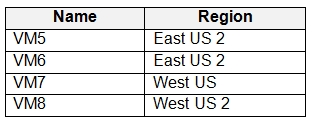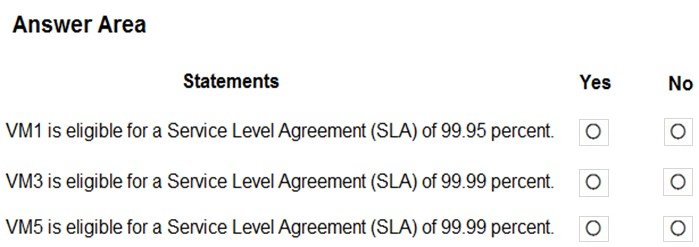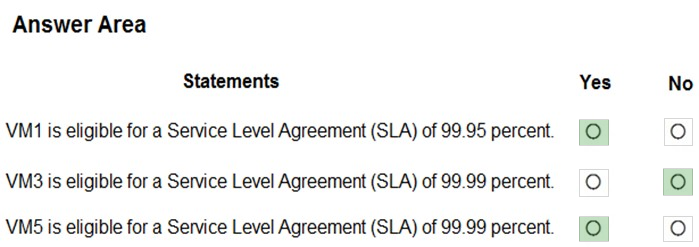

HOTSPOT -
You have an Azure subscription that contains the resource groups shown in the following table.
RG1 contains the virtual machines shown in the following table.
RG2 contains the virtual machines shown in the following table.
All the virtual machines are configured to use premium disks and are accessible from the Internet.
VM1 and VM2 are in an availability set named AVSET1. VM3 and VM4 are in the same availability zone. VM5 and VM6 are in different availability zones.
For each of the following statements, select Yes if the statement is true. Otherwise, select No.
NOTE: Each correct selection is worth one point.
Hot Area:

elguije
Highly Voted 4 years, 6 months agokrakenbite
3 years, 10 months agowidurr
4 years, 6 months agojamhaneef
4 years, 6 months agotita_tovenaar
4 years agodirector47
3 years, 9 months agoleeuw86
4 years, 5 months agopentium75
4 years agoarun
3 years, 4 months agoxaccan
Highly Voted 4 years, 7 months agoSumbasa
4 years, 6 months agoSumbasa
4 years, 6 months agoxaccan
4 years, 6 months agoKrsto
4 years, 5 months agotom999
4 years, 4 months agosviox
Most Recent 3 years, 4 months agomoon2351
3 years, 5 months agoplmmsg
3 years, 7 months agojmay
3 years, 7 months agoquantumray
3 years, 7 months agochupacabra
3 years, 9 months agoixl2pass
3 years, 10 months agoexamineezer
3 years, 10 months agoGtese
3 years, 10 months agosyu31svc
3 years, 11 months agoprecubcr
3 years, 11 months agonetwork_zeal
3 years, 11 months agoeliteone11
4 years agotita_tovenaar
4 years agoAAPaul
4 years agoAdityaGupta
4 years agosapna_tare
3 years, 4 months agoLinus0
4 years, 1 month ago